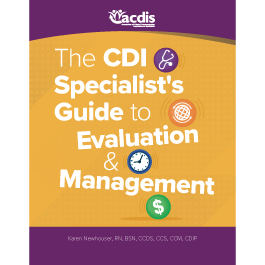Book excerpt: How to select an E/M code

Evaluation and Management
By Karen Newhouser, RN, BSN, CCDS, CCS, CCM, CDIP
The evaluation and management (E/M) section of the Current Procedural Terminology (CPT®) manual is divided into broad categories such as office visits, hospital visits, and consultations. E/M code assignment consists of seven components—three for medical decision making and history and examination, called key components, and the remaining four (nature of the presenting problem, counseling, coordination of care, and time) are called contributory components.
Most of the categories are further divided into two or more subcategories of E/M services. For example, there are two subcategories of office visits (new patient and established patient) and there are two subcategories of hospital visits (initial and subsequent). The subcategories of E/M services are further classified into levels of E/M services identified by specific codes. This classification is important because the nature of work varies by type of service, place of service, and the patient’s status.
Steps to selecting an E/M code
- Identify the place of service (e.g., office, inpatient hospital, emergency department) or type of service (consultation, critical care) provided.
- Identify the patient type (new or established), if applicable.
- Select the appropriate category and subcategory from the CPT® manual.
- Read the guidelines at the beginning of the category (office visits, hospital visits, etc.) and subcategory (new patient, established patient, initial, subsequent, etc.) to determine what special instructions, if any, apply.
- From the medical record documentation, determine whether this is an encounter describing counseling and/or coordination of care. If all the documentation requirements are met, assign the E/M code that matches the time in the E/M code description.
- If an E/M code based on time is not assigned, determine the complexity of the medical decision-making, the extent of the history, and the examination performed.
- Review the code narratives in the appropriate category and subcategory from within the CPT® manual. Each includes specific criteria that must be met or exceeded to assign the code correctly.
- Select the code that matches the levels of medical decision-making, history, and examination.
Editor’s note: This article is an excerpt from the CDI Specialist’s Guide to Evaluation and Management.
